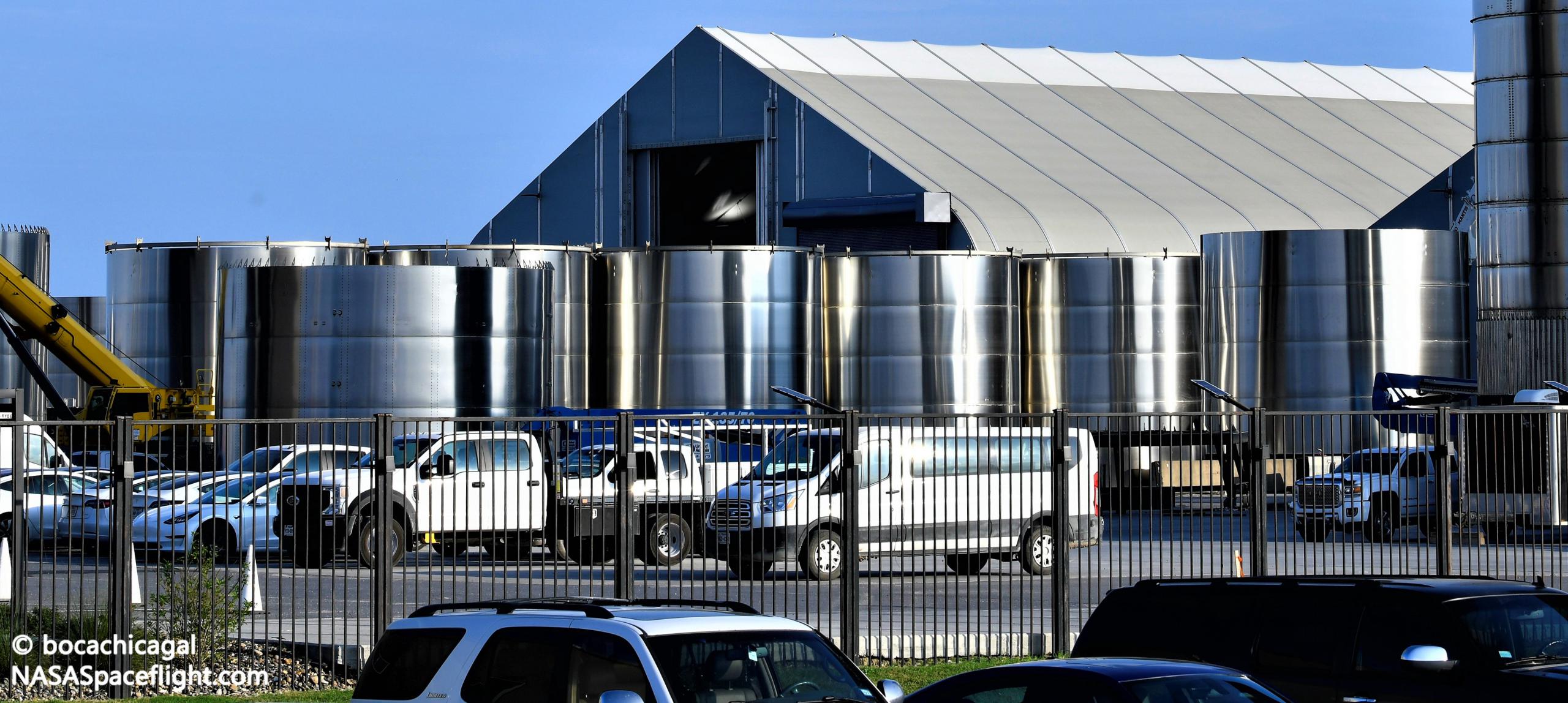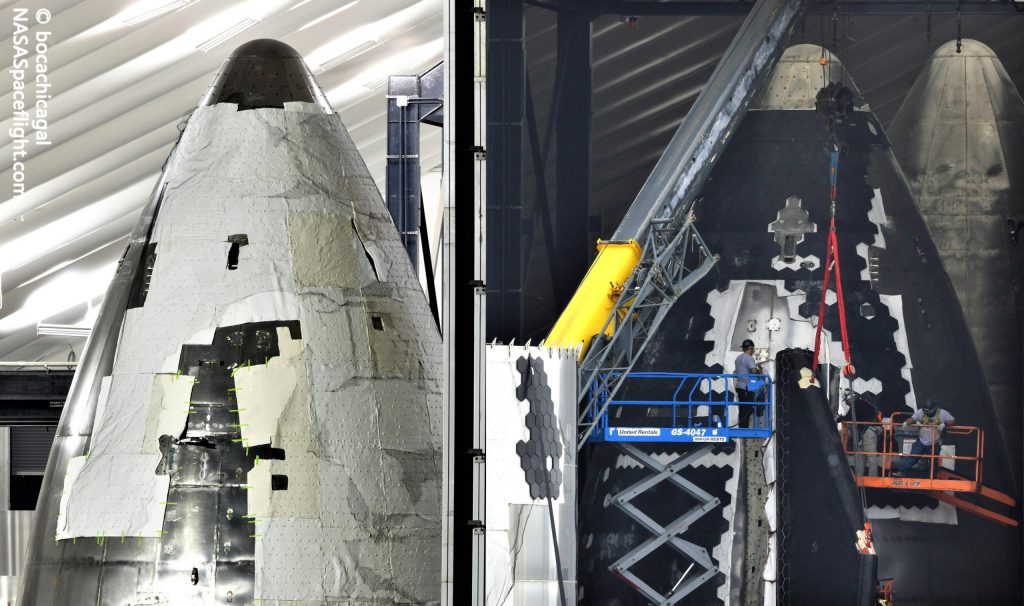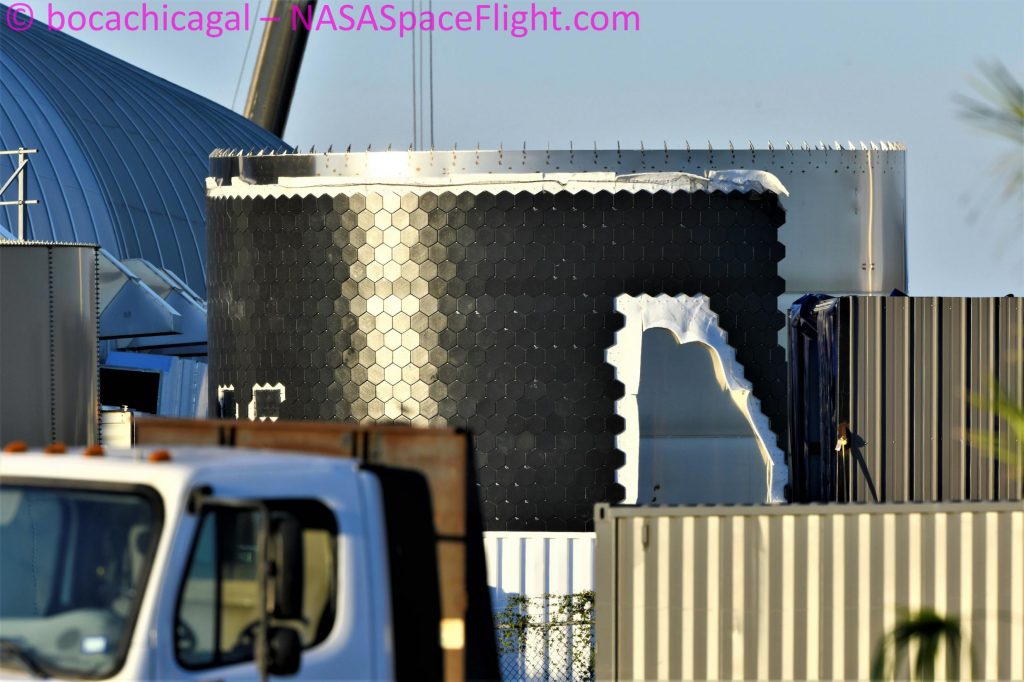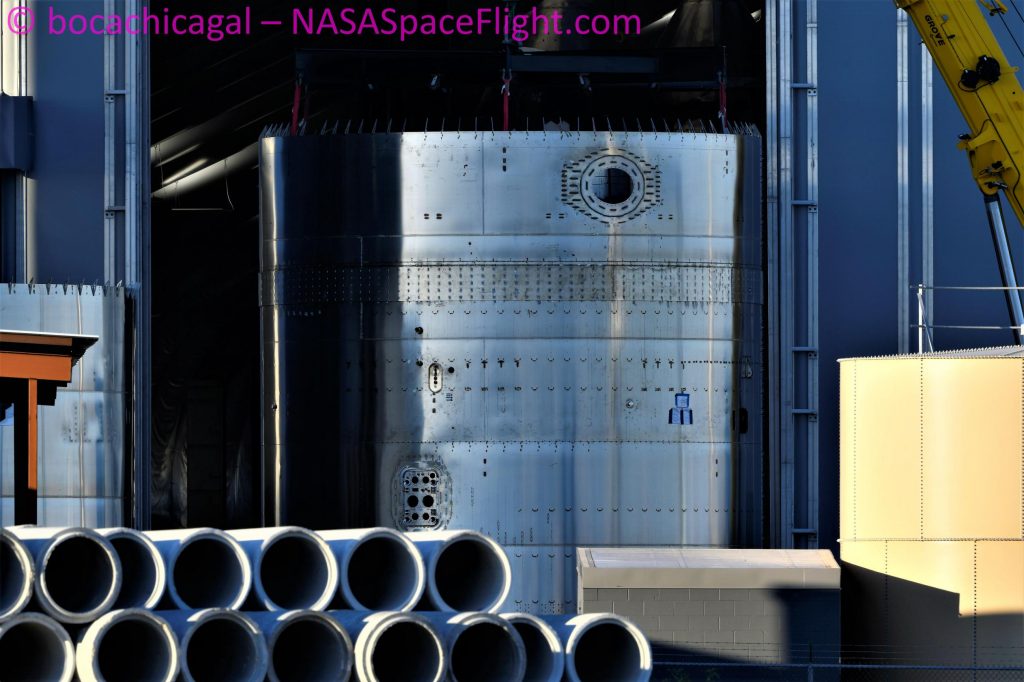

News
SpaceX Starbase construction takes priority as next orbital Starship, Super Heavy pair come together
As SpaceX teams slowly prepare the first orbital-class Starship and Super Heavy booster for the next-generation rocket’s first full-stack launch, the company has simultaneously begun assembling a second ship/booster pair. However, it’s clear that orbital pad construction remains a priority.
Known as Ship 20 and Booster 4, the two stages of the first orbital-class Starship first arrived at the launch site in early August. Only eight weeks later has Starship S20 finally become the first of the pair to attempt and complete one of two crucial proof tests, opening the door for one or several Raptor static fires in the coming week or two. Meanwhile, Booster 4 has had all 29 of its Raptor engines installed, uninstalled, and reinstalled and twice been placed on and removed from Starbase’s orbital launch mount in the same time frame but has yet to attempt any proof testing.
Despite the apparent delays and challenges slowing Ship 20 and Booster 4’s test debuts and two plodding FAA reviews that appear all but guaranteed to preclude an orbital launch attempt in 2021, though, SpaceX has recently begun assembling a second two-stage Starship.
Save for Starhopper back in 2019, no Starship or Super Heavy prototype has spent nearly as long at the launch site without a single test as Ship 20 and Booster 4 have. To an extent, there have likely been some technical delays while assembling, outfitting, and working with two first-of-their-kind prototypes. Still, the difference between past vehicles like Starship SN15 and Super Heavy Booster 3 are so stark that some portion of the testing delays almost has to be a conscious decision made by SpaceX.
To be able to fully proof and static fire test Super Heavy B4, SpaceX first needs to plumb, wire, and outfit Starbase’s orbital launch mount and complete a majority of the orbital pad’s massive tank farm. However, the orbital pad and its many unfinished systems are situated just a thousand (~300m) east of the suborbital launch site and Starship test facilities, which are complete and ready for testing. To test a Starship at those facilities, SpaceX has to entirely clear the pad of personnel – now several hundred people at the peak of construction – for 6-12+ hours.
The implication is that SpaceX management effectively chose to rip off the bandage now rather than later, sacrificing timely testing of Starship S20 to allow a near-total focus on orbital pad construction and activation over the last ~8 weeks. It’s hard to say if that’s paid off but the fact that SpaceX has chosen this particular moment to begin assembling the next orbital-class Starship and Super Heavy suggests that a clearer plan is starting to come together.
B4/S20, meet B5/S21
Parts of Starship S21 and Super Heavy B5 have been floating around Starbase’s build site for weeks. There was a multi-week period, for example, where the site’s massive high bay was effectively unused – clearly a conscious choice given SpaceX’s history of Starship prototype production earlier this year and late last. Parts of Super Heavy B5 were likely ready for assembly (i.e. stacking) by mid to late August. The ‘mid bay’ used for Starship tank section assembly has been similarly underutilized for even longer – only recently accepting its first Starship S21 section after supporting assembly of the orbital pad’s final storage tank.
Instead, Booster 5 stacking began around September 15th. At the current rate of assembly, which has slowed down considerably in the last week, SpaceX’s second flightworthy Super Heavy could reach its full 69m (~225 ft) height as early as mid-October. Starship S20 likely won’t be far behind. Further, thanks to SpaceX’s preferred style of continuous improvement, Booster 5 and Ship 21 production already appear well on track to outpace Booster 4 and Ship 20. With B5, rather than installing a range of external equipment (avionics, wiring, plumbing) after assembly is finished, SpaceX appears to be completing some of those subsystems during stacking, potentially speeding up final assembly by 1-2+ weeks. With S21, SpaceX has begun outfitting the Starship’s nose cone with heat shield tiles far earlier in the assembly process than it did with S20.



Given that it has taken SpaceX the better part of a month to finish and spot-fix Starship S20’s heat shield since the prototype’s second trip to the test site, taking those lessons learned to heart and getting Starship S21’s heat shield installation right on the first try could cut weeks from final assembly.
In the meantime, after completing Ship 20’s first cryoproof test on September 29th, SpaceX will hopefully be able to kick off the first six-engine Raptor static fire test campaign within the next week or so. With any luck, the start of B5/S21 assembly also means that the orbital launch pad is nearly ready to support Super Heavy B4’s first proof tests, even if static fires with anything close to a full set of 29 Raptors appear to be weeks away. Regardless, it looks like it won’t be long before SpaceX will be juggling two pairs of orbital-class Starships and Super Heavy boosters.

News
Tesla aims to combat common Full Self-Driving problem with new patent
Tesla writes in the patent that its autonomous and semi-autonomous vehicles are heavily reliant on camera systems to navigate and interact with their environment.

Tesla is aiming to combat a common Full Self-Driving problem with a new patent.
One issue with Tesla’s vision-based approach is that sunlight glare can become a troublesome element of everyday travel. Full Self-Driving is certainly an amazing technology, but there are still things Tesla is aiming to figure out with its development.
Unfortunately, it is extremely difficult to get around this issue, and even humans need ways to combat it when they’re driving, as we commonly use sunglasses or sun visors to give us better visibility.
Cameras obviously do not have these ways to fight sunglare, but a new patent Tesla recently had published aims to fight this through a “glare shield.”
Tesla writes in the patent that its autonomous and semi-autonomous vehicles are heavily reliant on camera systems to navigate and interact with their environment.

The ability to see surroundings is crucial for accurate performance, and glare is one element of interference that has yet to be confronted.
Tesla described the patent, which will utilize “a textured surface composed of an array of micro-cones, or cone-shaped formations, which serve to scatter incident light in various directions, thereby reducing glare and improving camera vision.”

The patent was first spotted by Not a Tesla App.
The design of the micro-cones is the first element of the puzzle to fight the excess glare. The patent says they are “optimized in size, angle, and orientation to minimize Total Hemispherical Reflectance (THR) and reflection penalty, enhancing the camera’s ability to accurately interpret visual data.”
Additionally, there is an electromechanical system for dynamic orientation adjustment, which will allow the micro-cones to move based on the angle of external light sources.
This is not the only thing Tesla is mulling to resolve issues with sunlight glare, as it has also worked on two other ways to combat the problem. One thing the company has discussed is a direct photon count.
CEO Elon Musk said during the Q2 Earnings Call:
“We use an approach which is direct photon count. When you see a processed image, so the image that goes from the sort of photon counter — the silicon photon counter — that then goes through a digital signal processor or image signal processor, that’s normally what happens. And then the image that you see looks all washed out, because if you point the camera at the sun, the post-processing of the photon counting washes things out.”
Future Hardware iterations, like Hardware 5 and Hardware 6, could also integrate better solutions for the sunglare issue, such as neutral density filters or heated lenses, aiming to solve glare more effectively.
Elon Musk
Delaware Supreme Court reinstates Elon Musk’s 2018 Tesla CEO pay package
The unanimous decision criticized the prior total rescission as “improper and inequitable,” arguing that it left Musk uncompensated for six years of transformative leadership at Tesla.

The Delaware Supreme Court has overturned a lower court ruling, reinstating Elon Musk’s 2018 compensation package originally valued at $56 billion but now worth approximately $139 billion due to Tesla’s soaring stock price.
The unanimous decision criticized the prior total rescission as “improper and inequitable,” arguing that it left Musk uncompensated for six years of transformative leadership at Tesla. Musk quickly celebrated the outcome on X, stating that he felt “vindicated.” He also shared his gratitude to TSLA shareholders.
Delaware Supreme Court makes a decision
In a 49-page ruling Friday, the Delaware Supreme Court reversed Chancellor Kathaleen McCormick’s 2024 decision that voided the 2018 package over alleged board conflicts and inadequate shareholder disclosures. The high court acknowledged varying views on liability but agreed rescission was excessive, stating it “leaves Musk uncompensated for his time and efforts over a period of six years.”
The 2018 plan granted Musk options on about 304 million shares upon hitting aggressive milestones, all of which were achieved ahead of time. Shareholders overwhelmingly approved it initially in 2018 and ratified it once again in 2024 after the Delaware lower court struck it down. The case against Musk’s 2018 pay package was filed by plaintiff Richard Tornetta, who held just nine shares when the compensation plan was approved.
A hard-fought victory
As noted in a Reuters report, Tesla’s win avoids a potential $26 billion earnings hit from replacing the award at current prices. Tesla, now Texas-incorporated, had hedged with interim plans, including a November 2025 shareholder-approved package potentially worth $878 billion tied to Robotaxi and Optimus goals and other extremely aggressive operational milestones.
The saga surrounding Elon Musk’s 2018 pay package ultimately damaged Delaware’s corporate appeal, prompting a number of high-profile firms, such as Dropbox, Roblox, Trade Desk, and Coinbase, to follow Tesla’s exodus out of the state. What added more fuel to the issue was the fact that Tornetta’s legal team, following the lower court’s 2024 decision, demanded a fee request of more than $5.1 billion worth of TSLA stock, which was equal to an hourly rate of over $200,000.
Delaware Supreme Court Elon Musk 2018 Pay Package by Simon Alvarez
News
Tesla Cybercab tests are going on overdrive with production-ready units
Tesla is ramping its real-world tests of the Cybercab, with multiple sightings of the vehicle being reported across social media this week.

Tesla is ramping its real-world tests of the Cybercab, with multiple sightings of the autonomous two-seater being reported across social media this week. Based on videos of the vehicle that have been shared online, it appears that Cybercab tests are underway across multiple states.
Recent Cybercab sightings
Reports of Cybercab tests have ramped this week, with a vehicle that looked like a production-ready prototype being spotted at Apple’s Visitor Center in California. The vehicle in this sighting was interesting as it was equipped with a steering wheel. The vehicle also featured some changes to the design of its brake lights.
The Cybercab was also filmed testing at the Fremont factory’s test track, which also seemed to involve a vehicle that looked production-ready. This also seemed to be the case for a Cybercab that was spotted in Austin, Texas, which happened to be undergoing real-world tests. Overall, these sightings suggest that Cybercab testing is fully underway, and the vehicle is really moving towards production.
Production design all but finalized?
Recently, a near-production-ready Cybercab was showcased at Tesla’s Santana Row showroom in San Jose. The vehicle was equipped with frameless windows, dual windshield wipers, powered butterfly door struts, an extended front splitter, an updated lightbar, new wheel covers, and a license plate bracket. Interior updates include redesigned dash/door panels, refined seats with center cupholders, updated carpet, and what appeared to be improved legroom.
There seems to be a pretty good chance that the Cybercab’s design has been all but finalized, at least considering Elon Musk’s comments at the 2025 Annual Shareholder Meeting. During the event, Musk confirmed that the vehicle will enter production around April 2026, and its production targets will be quite ambitious.








